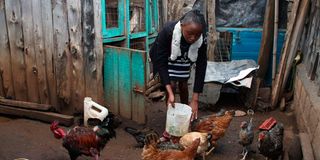How to improve egg and meat production in native chickens

Mary Njoroge, a small scale farmer, feeds her Kienyeji chickens in Mastima estate, Nakuru County on Wednesday. Giving birds high quality and well-balanced feeds improves performance.
Poultry makes up four percent of the livestock sector. The industry creates employment and the birds are a key source of protein.
The poultry sector is one of the most important pro-poor enterprises, particularly in rural Kenya.
Kenya has about 58.6 million domestic birds, 81 percent being indigenous chickens. The current poultry population is 4,187,154 broilers, 5,586,657 layers, 47,387,967 indigenous chickens, with the others being 1,444,330.
Kenya’s per capita poultry meat and egg consumption stands at 0.65kg and 1.6kg respectively, which is way below the WHO poultry meat and eggs requirement of 12kg and 9kg (180 eggs).
The poultry industry faces many challenges, the main one being supply of quality breeders. There are few sources of indigenous chicken breeding stock. Most farmers culled their breeding stock during the pandemic.
The average number of birds kept by farmers is 12. For economic sense, it recommended that a farmer has at least 150.
Also Read: Kalro introduces new improved chicken breed
The next challenge is feed quality and high cost. It should be noted that 70 per cent of raw materials are imports.
Farmers also have to contend with poor accessibility of inputs and services, high incidence of diseases, weak producer organisations, haphazard cross-breeding, poor marketing, inefficient and inadequate processors and lack of customised business and financial services.
Those dealing in broilers and layers face competition from imports.
The government has come up with policies, regulations and guidelines to develop the industry.
The Livestock Department and stakeholders support farmers through formation of user groups, training and linking them to markets. Slaughter facilities have been built in Chwele, Turbo and another is coming up in Nandi. They are also supporting groups with month-old chicks and building a modern hatchery and poultry farm in Marimanti.
Giving birds high quality and well-balanced feeds improves performance. Feeding should be done in the morning and evening to reduce energy wastage. Use of home-made feed rations reduces the cost of production.
Despite slow growth and low egg-laying, indigenous birds are still considered the key resources of invaluable genetic and non-genetic economic traits.
Scavenging indigenous chickens lay about 60 eggs a year but egg production doubles with supplements.
Improved indigenous chickens mature at four to five months and may lay 240 eggs.
Farmers can be trained on growing maggots and trapping termites to improve feed protein content.
Broodiness, a trait that retards laying performance, is common in indigenous birds. Native hens become broody after laying a small number of eggs. Chick brooding refers to the early periods of growth, when chicks are unable to maintain their body temperature without auxiliary heat .
A hen lays and broods her eggs until they hatch. She continues to rear the chicks and ceases to lay eggs. This may take up to 101 days.
Also Read: Egg prices rise amid shortage
Losses of 80 per cent often occur in natural brooding. Appropriate technology can be applied to increase productivity of indigenous chickens.
Synchronised hatching involves several hens hatching at the same time. Identify hens that start laying within the same period and delay sitting by giving them one egg or dummies.
When all are broody, remove the dummies and give the hens enough eggs to sit on. After hatching, distribute chicks to few hens.
It is also possible to do relay hatching where hens sit on more than one batch of eggs in succession. Select hens with good characteristics and use them for hatching. When the eggs hatch, remove the chicks at night and replace them with a fresh batch of eggs.
Use of surrogate mothers can increase production too. Turkeys, ducks or guinea fowls sit on chicken eggs. One is given 30-50 eggs.
Artificial chick brooding saves the hen from long broody periods. Chicks of different ages may be brooded together. In this way, the other hens can go back to laying.
A farmer can also adopt the improved Chebukube brooder. A structure is attached to a jiko and the heat provides warmth for the chicks. The brooder conserves heat and sustains warmth long after cooking.
Cold brooding can also be used. A hay box chick brooder is an example. It is a simple square box with a wire-mesh roof. It has a cover made of a sack filled with hay or straw. Insulation is also provided on the walls of the box. Feeding is on a separate run attached to the box, which can house up to 70 chicks.
Comprehensive vaccination and disease control reduces mortality and increases productivity.
The demand for poultry products has been rising but supply is low due to high human population growth.
Contact farming of raw materials can ensure farmers get feed at low prices. This will improve meat and egg production, making our farmers competitive in the EAC market.
Developing processing facilities through private-public partnership can spur production at farm level.
Subsidised inputs will reduce the cost of production and ultimately reduce cost of feeds.




